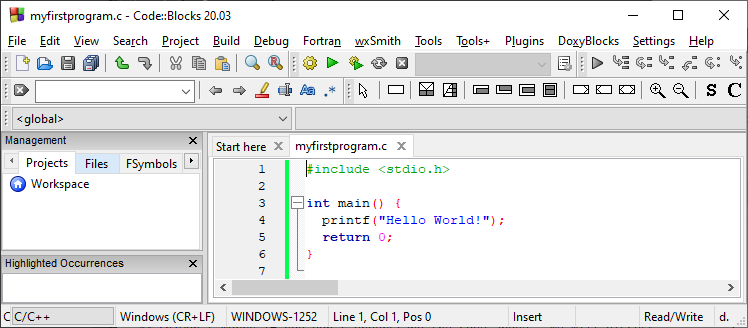# what is c.?
C is a general-purpose programming language created by Dennis Ritchie at the Bell Laboratories in 1972.
It is a very popular language, despite being old.
C is strongly associated with UNIX, as it was developed to write the UNIX operating system.
Why Learn C?
- It is one of the most popular programming language in the world
- If you know C, you will have no problem learning other popular programming languages such as Java, Python, C++, C#, etc, as the syntax is similar
- C is very fast, compared to other programming languages, like Java and Python
- C is very versatile; it can be used in both applications and technologies
Difference between C and C++
- C++ was developed as an extension of C, and both languages have almost the same syntax
- The main difference between C and C++ is that C++ support classes and objects, while C does not
C Get Started
To start using C, you need two things:
- A text editor, like Notepad, to write C code
- A compiler, like GCC, to translate the C code into a language that the computer will understand
There are many text editors and compilers to choose from. In this tutorial, we will use an IDE (see below).
C Install IDE
An IDE (Integrated Development Environment) is used to edit AND compile the code.
Popular IDE's include Code::Blocks, Eclipse, and Visual Studio. These are all free, and they can be used to both edit and debug C code.
Note: Web-based IDE's can work as well, but functionality is limited.
We will use Code::Blocks in our tutorial, which we believe is a good place to start.
You can find the latest version of Codeblocks at http://www.codeblocks.org/. Download the
mingw-setup.exefile, which will install the text editor with a compiler.C Quickstart
Let's create our first C file.
Open Codeblocks and go to File > New > Empty File.
Write the following C code and save the file as
myfirstprogram.c(File > Save File as):myfirstprogram.c
#include <stdio.h>
int main() {
printf("Hello World!");
return 0;
}Don't worry if you don't understand the code above - we will discuss it in detail in later chapters. For now, focus on how to run the code.
In Codeblocks, it should look like this:
Learning C Atdefaultjava56

Then, go to Build > Build and Run to run (execute) the program. The result will look something to this:
Hello World!
Process returned 0 (0x0) execution time : 0.011 s
Press any key to continue.Congratulations! You have now written and executed your first C program.
When learning C at W3Schools.com, you can use our "Try it Yourself" tool, which shows both the code and the result. This will make it easier for you to understand every part as we move forward:
myfirstprogram.c
Code:
#include <stdio.h>
int main() {
printf("Hello World!");
return 0;
}Result:Hello world!
Syntax
You have already seen the following code a couple of times in the first chapters. Let's break it down to understand it better:
Example
#include <stdio.h>
int main() {
printf("Hello World!");
return 0;
}Example explained
Line 1:
#include <stdio.h>is a header file library that lets us work with input and output functions, such asprintf()(used in line 4). Header files add functionality to C programs.Don't worry if you don't understand how
#include <stdio.h>works. Just think of it as something that (almost) always appears in your program.Line 2: A blank line. C ignores white space. But we use it to make the code more readable.
Line 3: Another thing that always appear in a C program, is
main(). This is called a function. Any code inside its curly brackets{}will be executed.Line 4:
printf()is a function used to output/print text to the screen. In our example it will output "Hello World!".Note that: Every C statement ends with a semicolon
;Note: The body of
int main()could also been written as:int main(){printf("Hello World!");return 0;}Remember: The compiler ignores white spaces. However, multiple lines makes the code more readable.
Line 5:
return 0ends themain()function.Line 6: Do not forget to add the closing curly bracket
}to actually end the main function.
Comments
Post a Comment